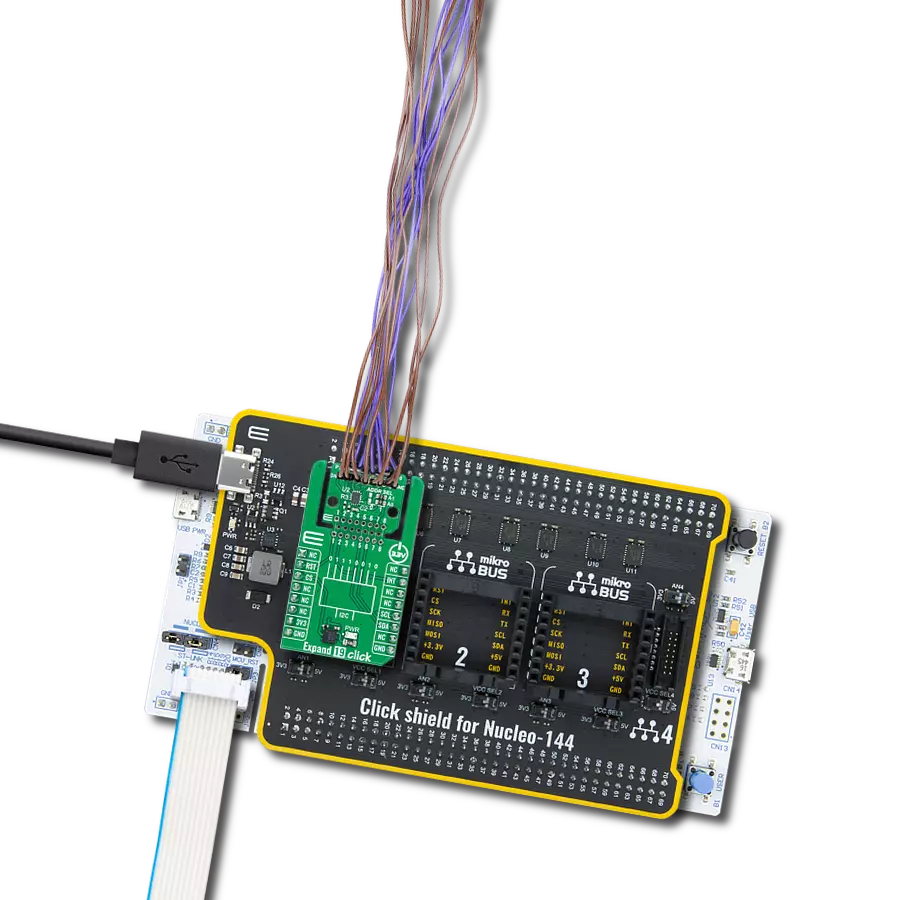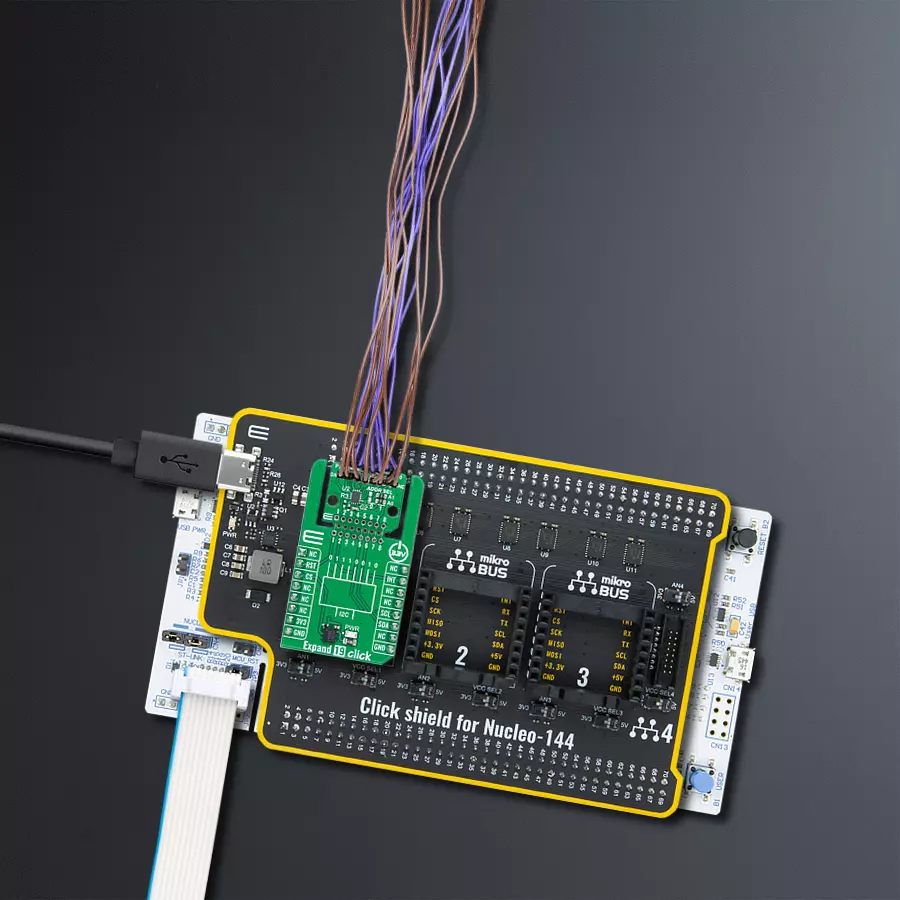Add additional general I/O pins for a variety of applications
A
A
Hardware Overview
How does it work?
Expand 19 Click is based on the TCAL9538, an 8-bit I2C-bus I/O expander from Texas Instruments. This Click board™ provides a simple solution for applications that require additional input/output lines, such as controlling switches, sensors, push-buttons, LEDs, and more. Operating at 3.3V, the TCAL9538 allows easy integration into existing systems using the standard two-wire I2C communication protocol. At its core, the TCAL9538 features 8-bit data registers that enable users to configure the I/O pins as inputs or outputs. Upon power-up or a software reset, all I/Os are set as inputs by default. However, they can be reconfigured by the host microcontroller through the Configuration registers. The data for each pin is stored in dedicated Input Port or Output Port registers, which are accessible for reading by the host MCU. Additionally, the polarity of the Input Port can be adjusted via the Polarity Inversion register, offering flexibility in design and signal interpretation. This Click board™ is designed in a
unique format supporting the newly introduced MIKROE feature called "Click Snap." Unlike the standardized version of Click boards, this feature allows the main sensor area to become movable by breaking the PCB, opening up many new possibilities for implementation. Thanks to the Snap feature, the TCAL9538 can operate autonomously by accessing its signals directly on the pins marked 1-8. Additionally, the Snap part includes a specified and fixed screw hole position, enabling users to secure the Snap board in their desired location. One of the key features of the TCAL9538 is its Agile I/O functionality, which enhances the performance of the I/O ports. This includes configurable output drive strength, programmable pull-up and pull-down resistors, latchable inputs, and maskable interrupts. The device also offers programmable open-drain or push-pull output modes, making it adaptable to various application requirements. These Agile I/O features provide the flexibility to optimize your design for power
consumption, speed, and electromagnetic interference (EMI). Expand 19 Click uses an I2C interface with clock speeds of up to 1MHz, ensuring fast and efficient communication with the host MCU. The I2C address can be easily configured via onboard jumpers, allowing multiple devices tocoexist on the same bus. Additionally, the board features an interrupt (INT) pin triggered whenever there is a change in the state of any input port, ensuring real-time response to external events, and a reset (RST) pin for power cycling to return the device to its default state. This ensures reliable operation and easy recovery in case of unexpected issues. This Click board™ can be operated only with a 3.3V logic voltage level. The board must perform appropriate logic voltage level conversion before using MCUs with different logic levels. Also, it comes equipped with a library containing functions and an example code that can be used as a reference for further development.
Features overview
Development board
Nucleo-144 with STM32L4R5ZI MCU board offers an accessible and adaptable avenue for users to explore new ideas and construct prototypes. It allows users to tailor their experience by selecting from a range of performance and power consumption features offered by the STM32 microcontroller. With compatible boards, the
internal or external SMPS dramatically decreases power usage in Run mode. Including the ST Zio connector, expanding ARDUINO Uno V3 connectivity, and ST morpho headers facilitate easy expansion of the Nucleo open development platform. The integrated ST-LINK debugger/programmer enhances convenience by
eliminating the need for a separate probe. Moreover, the board is accompanied by comprehensive free software libraries and examples within the STM32Cube MCU Package, further enhancing its utility and value.
Microcontroller Overview
MCU Card / MCU

Architecture
ARM Cortex-M4
MCU Memory (KB)
2048
Silicon Vendor
STMicroelectronics
Pin count
144
RAM (Bytes)
655360
You complete me!
Accessories
Click Shield for Nucleo-144 comes equipped with four mikroBUS™ sockets, with one in the form of a Shuttle connector, allowing all the Click board™ devices to be interfaced with the STM32 Nucleo-144 board with no effort. This way, MIKROE allows its users to add any functionality from our ever-growing range of Click boards™, such as WiFi, GSM, GPS, Bluetooth, ZigBee, environmental sensors, LEDs, speech recognition, motor control, movement sensors, and many more. Featuring an ARM Cortex-M microcontroller, 144 pins, and Arduino™ compatibility, the STM32 Nucleo-144 board offers limitless possibilities for prototyping and creating diverse applications. These boards are controlled and powered conveniently through a USB connection to program and efficiently debug the Nucleo-144 board out of the box, with an additional USB cable connected to the USB mini port on the board. Simplify your project development with the integrated ST-Link debugger and unleash creativity using the extensive I/O options and expansion capabilities. This Click Shield also has several switches that perform functions such as selecting the logic levels of analog signals on mikroBUS™ sockets and selecting logic voltage levels of the mikroBUS™ sockets themselves. Besides, the user is offered the possibility of using any Click board™ with the help of existing bidirectional level-shifting voltage translators, regardless of whether the Click board™ operates at a 3.3V or 5V logic voltage level. Once you connect the STM32 Nucleo-144 board with our Click Shield for Nucleo-144, you can access hundreds of Click boards™, working with 3.3V or 5V logic voltage levels.
Used MCU Pins
mikroBUS™ mapper
Take a closer look
Click board™ Schematic

Step by step
Project assembly
Track your results in real time
Application Output
1. Application Output - In Debug mode, the 'Application Output' window enables real-time data monitoring, offering direct insight into execution results. Ensure proper data display by configuring the environment correctly using the provided tutorial.

2. UART Terminal - Use the UART Terminal to monitor data transmission via a USB to UART converter, allowing direct communication between the Click board™ and your development system. Configure the baud rate and other serial settings according to your project's requirements to ensure proper functionality. For step-by-step setup instructions, refer to the provided tutorial.

3. Plot Output - The Plot feature offers a powerful way to visualize real-time sensor data, enabling trend analysis, debugging, and comparison of multiple data points. To set it up correctly, follow the provided tutorial, which includes a step-by-step example of using the Plot feature to display Click board™ readings. To use the Plot feature in your code, use the function: plot(*insert_graph_name*, variable_name);. This is a general format, and it is up to the user to replace 'insert_graph_name' with the actual graph name and 'variable_name' with the parameter to be displayed.

Software Support
Library Description
This library contains API for Expand 19 Click driver.
Key functions:
expand19_set_pin_direction- This function sets the direction of the selected pins.expand19_set_all_pins_value- This function sets the value of all output pins.expand19_read_port_value- This function reads the value of all input pins.
Open Source
Code example
The complete application code and a ready-to-use project are available through the NECTO Studio Package Manager for direct installation in the NECTO Studio. The application code can also be found on the MIKROE GitHub account.
/*!
* @file main.c
* @brief Expand 19 Click example
*
* # Description
* This example demonstrates the use of Expand 19 Click board by setting and
* reading the port state.
*
* The demo application is composed of two sections :
*
* ## Application Init
* Initializes the driver and performs the Click default configuration which sets
* the pins 0-3 as output and others as input with pull-up enabled.
*
* ## Application Task
* Sets the output pins and then reads the status of all pins and
* displays the results on the USB UART approximately once per second.
*
* @author Stefan Filipovic
*
*/
#include "board.h"
#include "log.h"
#include "expand19.h"
static expand19_t expand19;
static log_t logger;
void application_init ( void )
{
log_cfg_t log_cfg; /**< Logger config object. */
expand19_cfg_t expand19_cfg; /**< Click config object. */
/**
* Logger initialization.
* Default baud rate: 115200
* Default log level: LOG_LEVEL_DEBUG
* @note If USB_UART_RX and USB_UART_TX
* are defined as HAL_PIN_NC, you will
* need to define them manually for log to work.
* See @b LOG_MAP_USB_UART macro definition for detailed explanation.
*/
LOG_MAP_USB_UART( log_cfg );
log_init( &logger, &log_cfg );
log_info( &logger, " Application Init " );
// Click initialization.
expand19_cfg_setup( &expand19_cfg );
EXPAND19_MAP_MIKROBUS( expand19_cfg, MIKROBUS_1 );
if ( I2C_MASTER_ERROR == expand19_init( &expand19, &expand19_cfg ) )
{
log_error( &logger, " Communication init." );
for ( ; ; );
}
if ( EXPAND19_ERROR == expand19_default_cfg ( &expand19 ) )
{
log_error( &logger, " Default configuration." );
for ( ; ; );
}
log_info( &logger, " Application Task " );
}
void application_task ( void )
{
uint8_t port_value = 0;
for ( uint16_t pin_num = EXPAND19_PIN_0_MASK; pin_num <= EXPAND19_PIN_3_MASK; pin_num <<= 1 )
{
expand19_set_all_pins_value( &expand19, pin_num );
expand19_read_port_value( &expand19, &port_value );
log_printf( &logger, " Port status: 0x%.2X\r\n", ( uint16_t ) port_value );
Delay_ms( 1000 );
}
}
int main ( void )
{
/* Do not remove this line or clock might not be set correctly. */
#ifdef PREINIT_SUPPORTED
preinit();
#endif
application_init( );
for ( ; ; )
{
application_task( );
}
return 0;
}
// ------------------------------------------------------------------------ END


































